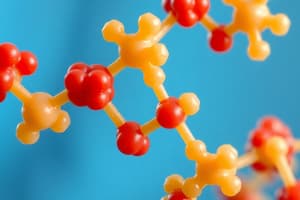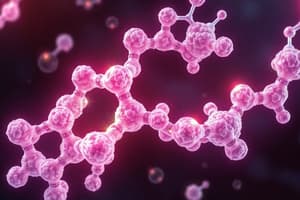Podcast
Questions and Answers
Which of the following is a primary function of carbohydrates in the body?
Which of the following is a primary function of carbohydrates in the body?
- Providing a long-term source of energy
- Acting as a catalyst for biological reactions
- Acting as a storage form of energy (correct)
- Serving as a structural component of cell membranes
Carbohydrates are only used for energy and have no structural roles in living organisms.
Carbohydrates are only used for energy and have no structural roles in living organisms.
False (B)
The empirical formula (CH2O)n applies to many simpler carbohydrates. What does this formula suggest?
The empirical formula (CH2O)n applies to many simpler carbohydrates. What does this formula suggest?
- Carbohydrates are composed of carbon, hydrogen, and oxygen, effectively a 'hydrate of carbon'. (correct)
- Carbohydrates are composed of carbon, hydrogen, and oxygen in a 2:1 ratio.
- Carbohydrates always form ring structures.
- Carbohydrates contain one carbon atom for every two water molecules.
_____________ are simple sugars that cannot be hydrolyzed into simpler carbohydrates.
_____________ are simple sugars that cannot be hydrolyzed into simpler carbohydrates.
Which of the following is a disaccharide?
Which of the following is a disaccharide?
Oligosaccharides contain more monosaccharide units than polysaccharides.
Oligosaccharides contain more monosaccharide units than polysaccharides.
What is the primary difference between aldoses and ketoses?
What is the primary difference between aldoses and ketoses?
What structural characteristic determines if a monosaccharide is classified as a triose, tetrose, pentose, or hexose?
What structural characteristic determines if a monosaccharide is classified as a triose, tetrose, pentose, or hexose?
A molecule is identified as a pyranose. What does this indicate about its structure?
A molecule is identified as a pyranose. What does this indicate about its structure?
In a Haworth projection, the -OH group on the anomeric carbon is always cis to the CH2OH group for the alpha (α) configuration.
In a Haworth projection, the -OH group on the anomeric carbon is always cis to the CH2OH group for the alpha (α) configuration.
If a monosaccharide is written in a Fischer projection and the -OH group on the chiral center farthest from the carbonyl is on the right, it is a:
If a monosaccharide is written in a Fischer projection and the -OH group on the chiral center farthest from the carbonyl is on the right, it is a:
What term describes carbohydrates that are isomers differing in configuration around only one specific carbon atom?
What term describes carbohydrates that are isomers differing in configuration around only one specific carbon atom?
Which of the following pairs of monosaccharides are enantiomers?
Which of the following pairs of monosaccharides are enantiomers?
The vast majority of sugars in humans are L-sugars.
The vast majority of sugars in humans are L-sugars.
What type of bond is formed when two monosaccharides are joined together?
What type of bond is formed when two monosaccharides are joined together?
In a glycoside, the -OH of the anomeric carbon has been replaced by a(n) ________ group.
In a glycoside, the -OH of the anomeric carbon has been replaced by a(n) ________ group.
A disaccharide is formed using carbon 1 of β-galactose and carbon 4 of glucose. How would this be described?
A disaccharide is formed using carbon 1 of β-galactose and carbon 4 of glucose. How would this be described?
Match the disaccharide with its component monosaccharides:
Match the disaccharide with its component monosaccharides:
All polysaccharides are composed of the same monosaccharide units.
All polysaccharides are composed of the same monosaccharide units.
What is the general scientific term for polysaccharides?
What is the general scientific term for polysaccharides?
What is a key difference between glycogen and cellulose?
What is a key difference between glycogen and cellulose?
What are the two types of molecules that compose starch?
What are the two types of molecules that compose starch?
Amylopectin is a branched polymer of glucose found in plants.
Amylopectin is a branched polymer of glucose found in plants.
Where is glycogen primarily stored in the human body?
Where is glycogen primarily stored in the human body?
_________ is a readily mobilized storage form of glucose in animals.
_________ is a readily mobilized storage form of glucose in animals.
Which type of glycosidic bond is present in glycogen?
Which type of glycosidic bond is present in glycogen?
The main function of cellulose is to store glucose in animal cells.
The main function of cellulose is to store glucose in animal cells.
How does branching affect the structure of glycogen?
How does branching affect the structure of glycogen?
What enzymes are required to break down glycogen into glucose?
What enzymes are required to break down glycogen into glucose?
In ____, the glycosidic bond is formed between carbon 1 of β-galactose and carbon 4 of glucose.
In ____, the glycosidic bond is formed between carbon 1 of β-galactose and carbon 4 of glucose.
Which structure is characteristic of amylose?
Which structure is characteristic of amylose?
Match each carbohydrate source with its primary glycosidic bonds:
Match each carbohydrate source with its primary glycosidic bonds:
Glucose residues in glycogen are linked by β-1,4-glycosidic bonds.
Glucose residues in glycogen are linked by β-1,4-glycosidic bonds.
Why is celluloses indigestible by humans?
Why is celluloses indigestible by humans?
What is the key biochemical advantage of having glycogen highly branched?
What is the key biochemical advantage of having glycogen highly branched?
Cellulose is a polymer of D-glucose unites per molecule joined by____________ glycosidic bond.
Cellulose is a polymer of D-glucose unites per molecule joined by____________ glycosidic bond.
Which of the following is an accurate description of monosaccharides?
Which of the following is an accurate description of monosaccharides?
Amylose is composed of highly branched structures that contain α-1,6 glycosidic bonds.
Amylose is composed of highly branched structures that contain α-1,6 glycosidic bonds.
What structural feature of cellulose makes it an excellent structural component of plant cell walls?
What structural feature of cellulose makes it an excellent structural component of plant cell walls?
The main storage polysaccharide in plants is ________.
The main storage polysaccharide in plants is ________.
Flashcards
Carbohydrates
Carbohydrates
Organic molecules abundant in nature
Storage form of energy
Storage form of energy
Energy storage for the body
Nucleic acid components
Nucleic acid components
Essential parts of nucleic acids.
Carbohydrates structural role
Carbohydrates structural role
Signup and view all the flashcards
Monosaccharides
Monosaccharides
Signup and view all the flashcards
Disaccharides
Disaccharides
Signup and view all the flashcards
Oligosaccharides
Oligosaccharides
Signup and view all the flashcards
Polysaccharides
Polysaccharides
Signup and view all the flashcards
Aldoses
Aldoses
Signup and view all the flashcards
Ketoses
Ketoses
Signup and view all the flashcards
Pyranose
Pyranose
Signup and view all the flashcards
Furanose
Furanose
Signup and view all the flashcards
Pyranose form dominance
Pyranose form dominance
Signup and view all the flashcards
Anomeric carbon
Anomeric carbon
Signup and view all the flashcards
Anomers
Anomers
Signup and view all the flashcards
Stereoisomers
Stereoisomers
Signup and view all the flashcards
Enantiomers
Enantiomers
Signup and view all the flashcards
Diastereomers
Diastereomers
Signup and view all the flashcards
D- Monosaccharides
D- Monosaccharides
Signup and view all the flashcards
L- Monosaccharides
L- Monosaccharides
Signup and view all the flashcards
Isomers
Isomers
Signup and view all the flashcards
Epimers
Epimers
Signup and view all the flashcards
Enantiomers
Enantiomers
Signup and view all the flashcards
Glycoside
Glycoside
Signup and view all the flashcards
Glycosidic bond
Glycosidic bond
Signup and view all the flashcards
Anomeric carbons
Anomeric carbons
Signup and view all the flashcards
Lactose
Lactose
Signup and view all the flashcards
Sucrose
Sucrose
Signup and view all the flashcards
Maltose
Maltose
Signup and view all the flashcards
Polysaccharides
Polysaccharides
Signup and view all the flashcards
Glycogen
Glycogen
Signup and view all the flashcards
Glycogen bonds
Glycogen bonds
Signup and view all the flashcards
Glucose role
Glucose role
Signup and view all the flashcards
Glycogen Breakdown
Glycogen Breakdown
Signup and view all the flashcards
Starch
Starch
Signup and view all the flashcards
Starch types
Starch types
Signup and view all the flashcards
Starch breakdown
Starch breakdown
Signup and view all the flashcards
Cellulose
Cellulose
Signup and view all the flashcards
Study Notes
- Carbohydrates are organic molecules, which are abundant in nature
- They have a wide range of functions
- Some functions include providing energy and acting as an energy storage within the body
- Cell membranes have components that the carbohydrates serve as
- Nucleic acids are components which have carbohydrates such as D-ribose (RNA) and 2-deoxyribose(DNA)
Structural Components
- Carbohydrates serve as structural components of many organisms
- The cell walls of bacteria include carbohydrates
- The exoskeleton of many insects has carbohydrates
- The fibrous cellulose of plants are carbohydrates
Chemical Formula
- The empiric formula for the carbohydrates is (CH2O)n
- This is where the name "hydrate of carbon" is derived
Classification of Carbohydrates
- Carbohydrates can be classified as Monosaccharides, Disaccharides, Oligosaccharides, and Polysaccharides
Monosaccharides
- Monosaccharides are simple sugars that cannot be hydrolyzed to simpler carbohydrates
Disaccharides
- Disaccharides are 2 monosaccharides covalently linked
Oligosaccharides
- Oligosaccharides are a few monosaccharides covalently linked (3- 10 monosaccharides)
Polysaccharides
- Polysaccharides are polymers consisting of chains of monosaccharide or disaccharide
Building blocks
- Monosaccharides are building blocks of all carbohydrates
- Classified according to the number of carbon atoms the monosaccharides contain
Atoms by Count
- 3C: trioses
- 4C: tetroses
- 5C: pentoses
- 6C: hexoses
Types
- Monosaccharides can be either aldoses, containing an aldehyde group
- Or ketoses, containing a ketone group
Cyclization
- Monosaccharides are predominantly found in a cyclic, ring formation
- Aldehyde or ketone reacts with an alcohol group on the same sugar
Linear Chain
- Less than 1% of each of the monosaccharides with five or more carbons exists in the open-chain (acyclic) form
Six-Membered Ring
- Pyranose refers to a six-membered ring consisting of five carbons and one oxygen (e.g., glucopyranose)
Five-Membered Ring
- Furanose denotes a five-membered ring with four carbons and one oxygen
- The pyranose form of glucose dominates (>99%) at equilibrium in aqueous solution
Anomeric Carbon
- Cyclization creates an anomeric carbon
- The former carbonyl carbon generates the a and β configurations of the sugar
- Glucose's a-D-glucopyranose and β-D-glucopryanose
Isomers
- Two sugars are both glucose but are anomers
Alpha configuration
- The OH on the anomeric C projects to the same side as the ring in a modified Fischer projection formula
- Of Haworth projection formula of the α configuration, this OH is trans to the CH2OH group
Fischer Projection
- A modified Fischer projection formulas shows the interconversion of α and β anomeric forms of glucose
Haworth projection formulas
- A Haworth projection formulas shows the interconversion
Fischer Projection
- Bonds are written in a two dimensional form depicting vertical and horizontal relationships with tetrahedral stereocenters
- For sugars with more than one chiral centre, D or L refers to the asymmetric C farthest from the aldehyde or keto group
- The most naturally sugars are D
D- Monosaccharide
- The -OH is on the right when written as Fischer projection
L- Monosaccharide
- The -OH is on the left when written as Fischer projection
Isomers and Epimers
- Isomers are compounds with the same chemical formula but different structures
- Fructose, glucose, mannose, and galactose are isomers having the same chemical formula C6H12O6
- Carbohydrate isomers with different configurations around one specific carbon atom (not carbonyl) are called epimers
- Glucose and galactose, for example, are C-4 epimers, only differing by their -OH group's position on carbon 4
- Glucose and mannose are C-2 epimers
- Galactose and mannose are not epimers due to differences in -OH at carbons 2 and 4, simply isomers
Examples
- Mannose is a C-2 epimer of glucose
- Galactose is a C-4 epimer of glucose
- Fructose is an isomer of glucose
- Mannose is also a component of glycoproteins
Enantiomers
- Have a special type of isomerism in the pairs of structures, which are mirror images
- These mirror images are enantiomers, named as a D- and an L- sugar
- The vast majority of human sugars are D-sugars
- In the D isomeric form, the OH group is on the right of the asymmetric carbon(groups) farthest from the carbonyl carbon
Joining Monosaccharides
- Monosaccharides are joined to form disaccharides, oligosaccharides, and polysaccharides
- Glycoside: The -OH of an anomeric carbon in sugar molecules are replaced by -OR (another group)
- Glycosidic bond: The bond that connects sugars
- Bond from the anomeric carbon to the -OR group
- The anomeric carbon of one sugar is linked to -OH groups of another
- Happens when forming an α- or β-glycosidic linkages
Glycosidic Bonds
- Glycosidic bonds between sugars are named according to the location of connected carbons in this structure
- Can also be named according to position of the anomeric hydroxyl group of the sugar (Alpha and Beta bonds)
- In Lactose: It is synthesized by glycosidic bonding between carbon 1 of β-galactose and carbon 4 of glucose, making up a β(1→4) glycosidic-bond
Disaccharides Compositions
- Lactose: D-galactose and D-glucose, by way of β-1,4 glycosidic bond
- Sucrose (table sugar): D-glucose and D-fructose joined by α-1,2 glycosidic bond
- Maltose: two units of D-glucose, joined by α-1,4 glycosidic bond
Polysaccharides
- Most carbohydrates exist as polysaccharides
- The scientific term for this is "glycans"
- These differ from each other because of monosaccharide units, length of chains, types of linking bonds and degree of branching
- Glycogen (animal sources)- Polymer of α-D-glucose units, joined by α-1,4 and α-1,6 glycosidic bond
- Starch (plant sources)- Polymer of α-D-glucose units, joined and α-1,6 glycosidic bond
- Cellulose (plant sources)- Polymer of D-glucose per a singular molecule, joined by β-1,4 glycosidic bond
Glycogen Details
- Glycogen has mobilized storage of glucose
- It is very sizable, with highly branched polymer of glucose residues to break down for high amount of energy
- Glucose residues in glycogen happen by α-1,4-glycosidic bonds
- Branches at every 10 residue by α-1,6-glycosidic bonds
- Glycogen is typically stored in the liver and skeletal muscle
- Blood-glucose will be maintained through glycogen; which is what the brain uses
More on Storage
- Glycogen is ingested with diet, and is hydrolyzed by α-amylases to break (α 1-4 ) glycosidic bonds between glucose molecules
- Followed by using debranching enzymes to break for (α 1-6 ) glycosidic bonds
Starch Details
- A Polymeric carbohydrate of the numerous glucose units joined by way of 𝛼 1-4 and 𝛼 1-6
- Main format of glucose stored in most plant life
- Glycogen serves as this analogue
- Consists of a linear amylose and branched amylopectin
- Once It enters the diet, it breaks downed again, by α-amylases to also break (α 1-4) branches of glucose molecules, and with debranching enzymes, breaks (α 1-6) for more glycosidic bonds
Studying That Suits You
Use AI to generate personalized quizzes and flashcards to suit your learning preferences.




